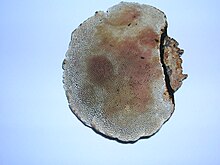Daedaleopsis Confragosa
Taxonomy
Daedaleopsis confragosa was first described scientifically under the name Boletus confragosus by English naturalist James Bolton, in his 1791 work An History of Fungusses, growing about Halifax. He reported finding specimens on old trees near Fixby Hall, and having specimens sent to him from Darlington. The species has been shuffled between several genera in its taxonomic history: Daedalea by Christian Hendrik Persoon in 1801; Trametes by Gottlob Ludwig Rabenhorst in 1844; Polyporus by Paul Kummer in 1871; Stigila by Otto Kuntze in 1891; Lenzites by Patouillard in 1900; Agaricus by William Alphonso Murrill in 1905; and Ischnoderma by Ivan Zmitrovich in 2001. It was transferred to its current genus, Daedaleopsis, by German mycologist Joseph Schröter in 1888. D. confragosa is the type species of the genus Daedaleopsis.
Several varieties have been described. L. Ljubarskii published var. bulliardi and var. rubecens in 1975. Both of these varieties were published invalidly are not considered to have independent taxonomic significance: variety rubescens is folded into synonymy with the main variety, while variety bulliardi is now considered synonymous with Trametes suaveolens. Variety tricolor, proposed by Appollinaris Semenovich Bondartsev and Rolf Singer in 1953, is now the independent species Daedaleopsis tricolor. Bondartsev described the form sibirica in 1953, but this is also no longer independent.
The polypore has acquired several vernacular names, including "thin-maze flat polypore", "thin walled maze polypore", "blood-stained bracket", and "blushing bracket". The latter name refers to its characteristic bruising reaction. James Bolton referred to it as the "rugged boletus".
Description

The shelflike or bracketlike fruit body is fan-shaped to semicircular, and typically measures 5–15 cm (2–6 in) in diameter, and up to 2 cm (0.8 in) thick. Its upper surface is broadly convex to flat, dry, smooth to somewhat hairy, and usually has concentric zone lines. Its color ranges from reddish brown to brown to grayish, sometimes becoming blackish in maturity. The cap surface may have an umbo at the point of attachment to the substrate. Fruit bodies are leathery to corky when moist, but become hard and rigid when dry. The flesh is white to pinkish to brownish and tough. The underside of the fruit bodies features tiny pores measuring about 0.5–1.5 mm in diameter. They are white to tan to brown, but will develop pinkish or reddish tones if bruised. Pore shape is highly variable, ranging from circular to elongated, to mazelike, to gill-like. The tubes are up to 1.5 cm (0.6 in) long. The fruit body lacks a stalk, as the shelf attaches directly to the substrate. The inedible fruit bodies have no distinctive odor and a slightly bitter taste.
The spore print is white; spores are cylindrical, smooth, and measure 7–11 by 2–3 μm. The basidia (spore-bearing cells) have a shape ranging from cylindrical to club-shaped, and dimensions of 20–40 by 3–5 μm. The hymenium features numerous hyphidia (modified terminal hyphae), which measure 2–3 μm. The hyphal system of Daedaleopsis confragrosa is trimitic, meaning that there are three types of hyphae in the fruit body: skeletal hyphae, which provide structural support, are thick walled, measuring 3–7 μm in diameter; generative hyphae, responsible for new growth, can be either thin- or thick-walled, may contain clamps, and measure 2–6 μm; binding hyphae, thick-walled and much branched, are 2–5 μm.
The polypore is used in ornamental paper making, whereby the fruit bodies are pulped, pressed, and dried to produce sheets with unusual textures and colors.